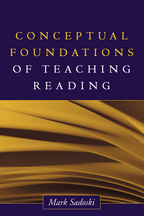Conceptual Foundations of Teaching Reading
Mark Sadoski
Paperback
Paperback
orderApril 22, 2004
ISBN 9781593850364
Price: $35.00 156 Pages
Size: 6" x 9"
This lucidly written book provides a concise conceptual map to guide preservice and inservice teachers through the often-confusing terrain of reading instruction. Distinguished researcher and former classroom teacher Mark Sadoski describes the essential concepts and methods of the field and summarizes key research findings and historical developments. The main competency areas in reading are explained, and widely used approaches to building these competencies are reviewed. Aided by quick-reference tables and other illustrations, readers gain a systematic framework to help them demystify the jargon of the field; organize their knowledge about curriculum and instruction; and implement well-thought-through practices in the K-6 classroom and beyond.
“[A] valuable resource for educators attempting to understand how reading is currently taught and conceptualized through various approaches and practices. Educators should finish the book feeling affirmed about where their practices fit in historically and methodologically. Beyond this, though, Sadoski has achieved something better: he has provided practitioners and researchers alike with a conceptual overview so clearly and lucidly written, this reviewer regards the opportunity to delve into the book again and to use it as a future resource with nothing less than pleasure.”
—English Quarterly
“By presenting a clear and organized conceptual map of essential concepts, the author challenges teachers to create a balanced program based on established and well-researched practices that address decoding, comprehension, and response. A must for both beginning and continuing elementary teachers.”
—Curriculum Connections
“We have adopted Conceptual Foundations of Teaching Reading for use with preservice secondary teachers. The text provides a cogent, research-based explanation of the reading process and instructional approaches. It includes a review of the history of reading instruction and a discussion of the current status of the field. This essential information serves as the foundation for content-area reading and writing, the major thrust of instruction in our secondary literacy course.”
—Ruth H. Freeman, PhD, Coordinator of Literacy Instruction, Madonna University
“This book presents a comprehensive picture of the 'whys,' 'whats,' and 'hows' of reading instruction. The essential components of teaching reading are presented within a highly understandable framework. Most importantly, the reader gains the knowledge needed to make informed decisions about his or her own teaching practices.”
—Diana Quatroche, PhD, School of Education, Indiana State University
“In clear and concise prose, Sadoski provides an historical overview of ideas in the teaching and learning of reading and offers both novice and experienced educators a valuable conceptual framework for organizing their understandings. The book is structured around four essential questions: why, what, how, and how well we teach. It encourages the creativity and professionalism of reading teachers in developing thoughtful, balanced approaches that meet the current and future needs of all their students—without leaving the mistaken impression that a balanced approach is either a haphazard collection of methods or a uniform, 'best method' approach across contexts.”
—Karla J. Möller, PhD, University of Illinois at Urbana-Champaign
“This book is a first: it maps the empirical and theoretical foundations for teaching reading, both conceptually and chronologically. Sadoski does his mapping of the field by sketching a 'big picture' view of the terrain, showing what an interesting and complex picture it continues to be. From start to finish, this book presents a fresh and comprehensive view of the field.”
—Douglas K. Hartman, PhD, University of Pittsburgh
Table of Contents
Preface and Acknowledgments1. Introduction, Background, and Structure of This Book
2. A Brief History of Teaching Reading
3. Why? The Goals of Teaching Reading
4. What? The Fundamental Competencies of Reading
5. How? I: Basic Teaching and Learning Approaches
6. How? II: A Map of the Territory
7. How? III: Exemplars of a Balanced Approach
8. How Well? The Status of Reading Achievement and Its Teaching
